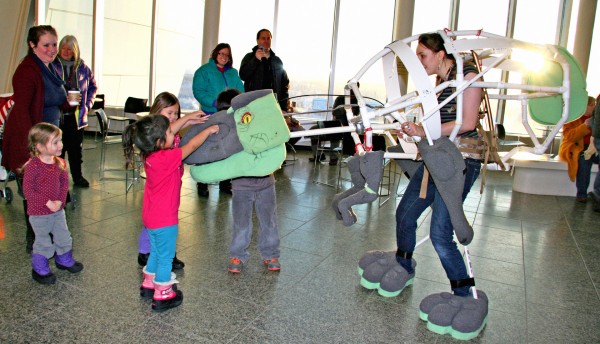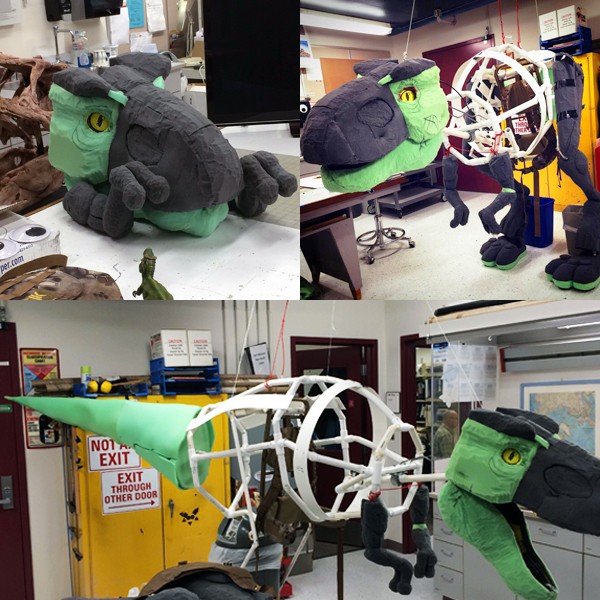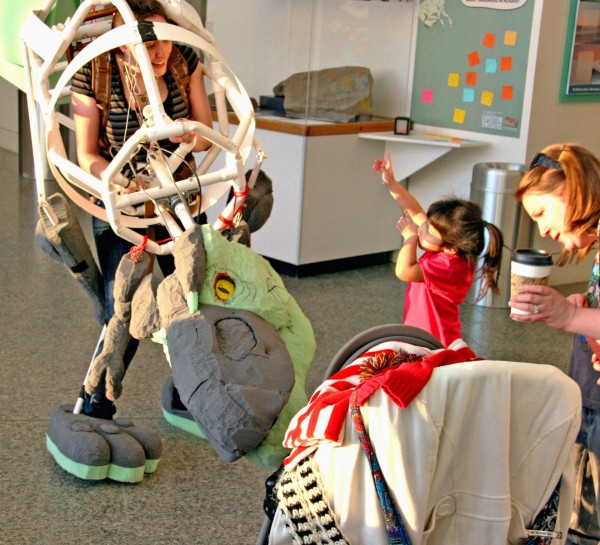Museum wants to help visitors walk with dinosaurs
February 26, 2015

Theresa Bakker
907-474-6941
2/25/15
Ever since people realized dinosaurs actually roamed the Earth, our imaginations have run wild. Today, most kids grow up with a favorite dinosaur and an understanding of the seemingly limitless possibilities those forms might take. For animator Hannah Foss, creating a life-sized dinosaur costume as part of the museum’s upcoming special exhibit was a dream come true.
“Back in 2006, I watched a 'Walking with Dinosaurs — The Arena Spectacular' workshop video on YouTube, and I was gripped with awe. That it was possible to make huge realistic dinosaurs really captured my imagination,” she said.
After coming to work at the museum in the exhibits and design team, it was clear that her co-workers shared her vision. After researching what it would take to make a “real dinosaur costume,” Snaps was born. “Snaps is a theropod, from the Tyrannosauridae,” Foss said. “He likes eating meat with his big carving teeth, but you don't have to worry because we feed him really well.”
To make the dinosaur seem alive, the team needed to work with materials that would act in a lifelike way. Steve Bouta, the museum’s exhibition and design coordinator, said the frame was fabricated from PVC pipe and bolted in a backpack frame so the operator could “wear” the beast. “For leg joints, we heated and flattened the end of one length of pipe, cut a slot in the end of the next section, then inserted tab A into slot B,” Bouta said. “We drilled a hole and pinned the two sections together with bolts. The neck is supported by a length of PVC pipe that pivots and turns on a sleeve bearing.”

The team also used sets of U joints and threaded rod to articulate the head and a simple push-pull control cable to operate the mouth. The tail pivots on pin joints where it meets the body, and half the length is made from flexible PVC sheet. The skull is a combination of foam and chicken-wire, and the outer fleshing of the dinosaur is upholstery foam, the same kind used in your sofa at home.
When the project is complete, Snaps will have bumpy, ridged skin with raised scales and a crest of feathers, like the tufted feathers you see on young birds. He'll have bright beady eyes. Visitors should like the look of him but wouldn't trust him alone near sandwiches or small children.
During her research, Foss was surprised and encouraged to find all kinds of people tackling such a big project. “Animatronic puppet building has this wonderful combination of challenge, imagination and magic," she said. "Who wouldn't want to try making their own real dinosaur?”
Foss knows what kind of connections can be made by using a life-sized puppet to interact with crowds of people. For three years, she was a “Nook” polar bear, the mascot for the University of Alaska Fairbanks' Nanooks athletic teams. In that costume, she learned how to read people and tell whether they want to interact, how to escape from rough kids, and — most importantly — how to stay in character.
The museum hopes Snaps will embody the information shared in the exhibit, so a visitor can interpret the individual specimens, facts and diagrams as a living, breathing dinosaur. “I hope that people can take what they've learned from the exhibit and see what drives all the parts of Snaps, from science's current understanding of their posture, behavior, diet, down to their recently discovered feathers,” Foss said.
“I guess it's kind of like the difference between reading about lion feeding behaviors on a placard and having the opportunity to be five feet from a living, breathing, pacing lioness waiting for her meal," she said. "It's electrifying and gives you a new respect for this fascinating animal with its own purpose and spark. The wonder and imagination helps you question, helps you learn.”

The exhibits team has been guided by the museum's Earth Sciences Curator Pat Druckenmiller, who is the expert behind the interpretation. He is keen to use Snaps from everything from public outreach to his paleontology classes at UAF. "Snaps is a fantastic teaching tool for all ages," he said.
The museum’s education department is also excited to take advantage of the costume, which was developed specifically for the upcoming special exhibit "Expedition Alaska: Dinosaurs."
“We would bring him out on a set schedule,” Foss said. “Come meet Snaps, but make sure he doesn't eat your lunch!”


